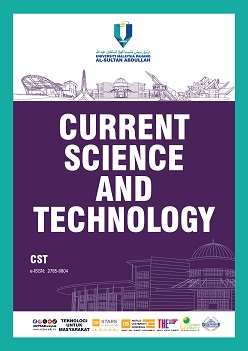Influence of Dopant Concentrations on Morphological and Optical Characteristics of Silver Doped Zinc Oxide Thin Films
DOI:
https://doi.org/10.15282/cst.v3i2.10483Keywords:
Sol-gel, ZnO, Ag-ZnOAbstract
Zinc oxide (ZnO) thin films are widely used in critical applications such as solar cells, sensors, photodetectors, and conductive layers. Many efforts have been made to modify the properties of ZnO through doping so that it can be used more widely in research fields. In this work, we report silver-doped zinc oxide (Ag-ZnO) thin films by varying the Ag concentrations between 0.05 and 0.25 wt.%. The samples were prepared through the sol-gel method, followed by the spin-coating technique onto glass substrates. The work aims to investigate how different Ag concentrations affect the morphological characteristics and optical properties of the prepared Ag-ZnO thin films. The spin-coated Ag-ZnO thin film thickness was controlled at three layers to ensure the adhesion of the nanoparticles. Field Emission Scanning Electron Microscope (FESEM) analysis showed that as the Ag concentration increased, the particles transitioned from spherical to flake-like morphologies with smaller grain sizes. The optical energy band gap was decreased to 3.17 eV from 3.28 eV (undoped ZnO) when the concentration of Ag was the highest at 0.25 wt.%. The findings reveal that Ag doping can tailor ZnO thin films morphology and energy band gap, expanding their potential use in optoelectronic and energy devices through enhanced surface area, catalytic activity, and light absorption capabilities.
References
[1] F. M. Sanakousar, C. C. Vidyasagar, V. M. Jiménez-Pérez and K. Prakash, “Recent progress on visible-light-driven metal and non-metal doped ZnO nanostructures for photocatalytic degradation of organic pollutants,” Materials Science in Semiconductor Processing, vol. 140, p. 106390, 2022.
[2] S. M. Hosseini, I. A. Sarsari, P. Kameli and H. Salamati, “Effect of Ag doping on structural, optical, and photocatalytic properties of ZnO nanoparticles. Journal of Alloys and Compounds, vol. 640, pp. 408-415, 2015.
[3] B. Mehmood, M. I. Khan, M. Iqbal, A. Mahmood and W. Al‐Masry, “Structural and optical properties of Ti and Cu co‐doped ZnO thin films for photovoltaic applications of dye sensitized solar cells,” International Journal of Energy Research, vol. 45, no. 2, pp. 2445-2459, 2021.
[4] P. Popielarski, L. Mosinska, W. Bala, K. Paprocki, Y. Zorenko and T. Zorenko, “Persistent photoconductivity in ZnO thin films grown on Si substrate by spin coating method,” Optical Materials, vol. 97, p. 109343, 2019.
[5] A. Habibi, L. Vatandoust, S. M. Aref and H. Naghshara, “Formation of high performance nanostructured ZnO thin films as a function of annealing temperature: Structural and optical properties,” Surfaces and Interfaces, vol. 21, p. 100723, 2020.
[6] E. Moyen, J. H. Kim, J. Kim and J. Jang, “ZnO nanoparticles for quantum-dot-based light-emitting diodes,” ACS Applied Nano Materials, vol. 3, no. 6, pp. 5203-5211, 2020.
[7] W. Han, J. Kim and H. H. Park, “Control of electrical conductivity of highly stacked zinc oxide nanocrystals by ultraviolet treatment,” Scientific reports, vol. 9, no. 1, p. 6244, 2019.
[8] T. C. Bharat, S. Mondal, H. S. Gupta, P. K. Singh and A. K. Das, “Synthesis of doped zinc oxide nanoparticles: A review,” Materials Today: Proceedings, vol. 11, pp. 767-775, 2019.
[9] E. Benrezgua, B. Deghfel, A. Zoukel, W. J. Basirun, A. Boukhari et al., “Synthesis and properties of copper doped zinc oxide thin films by sol-gel, spin coating and dipping: A characterization review,” Journal of Molecular Structure, vol. 1267, p. 133639, 2022.
[10] Alexandrov, A., Zvaigzne, M., Lypenko, D., Nabiev, I., & Samokhvalov, P. (2020). “Al-, Ga-, Mg-, or Li-doped zinc oxide nanoparticles as electron transport layers for quantum dot light-emitting diodes,” Scientific Reports, vol. 10, no. 1, p. 7496, 2020.
[11] S. D. Ponja, S. Sathasivam, I. P. Parkin and C. J. Carmalt, “Highly conductive and transparent gallium doped zinc oxide thin films via chemical vapor deposition,” Scientific Reports, vol. 10, no. 1, p. 638, 2020.
[12] R. Rajendran and A. Mani, “Photocatalytic, antibacterial and anticancer activity of silver-doped zinc oxide nanoparticles,” Journal of Saudi Chemical Society, vol. 24, no. 12, pp. 1010-1024, 2020.
[13] L. Xu, F. Xian, Y. Zhang and L. Zhang, “Surface segregation of Ag and its effect on the microstructure, optical properties and conduction type of ZnO thin films,” Physica B: Condensed Matter, vol. 566, pp. 103-115, 2019.
[14] M. Parashar, V. K. Shukla and R. Singh, “Metal oxides nanoparticles via sol–gel method: A review on synthesis, characterization and applications,” Journal of Materials Science: Materials in Electronics, vol. 31, pp. 3729-3749, 2020.
[15] K. Davis, R. Yarbrough, M. Froeschle, J. White and H. Rathnayake “Band gap engineered zinc oxide nanostructures via a sol–gel synthesis of solvent driven shape-controlled crystal growth,” RSC Advances, vol. 9, no. 26, pp. 14638-14648, 2019.
[16] A. Ullah, M. Saadullah, F. Alvi, L. Sherin, A. Ali, N. A. Shad et al., “Synergistic effect of silver doped ZnO nanomaterials enhances the anticancer potential against A459 lung cancer cells,” Journal of King Saud University-Science, vol. 34, no. 1, p. 101724, 2022.
[17] M. Arifuzzaman, T. Saha, J. Podder, F. Al-Bin and H. N. Das, “Effect of silver doping on the band gap tuning of tungsten oxide thin films for optoelectronic applications,” Heliyon, vol. 10, no. 6, 2024.
[18] N. K. Vijay, P. N. Maya, S. Mukherjee, M. O. Liedke, M. Butterling and A. G. Attallah, “Effect of annealing temperature on the structure and optical properties of ZnO thin films,” Journal of Physics: Condensed Matter, vol. 36, no. 13, p. 135002, 2023.
[19] S. Kumar, V. Singh and A. Tanwar, “Structural, morphological, optical and photocatalytic properties of Ag-doped ZnO nanoparticles,” Journal of Materials Science: Materials in Electronics, vol. 27, pp. 2166-2173, 2016.
[20] S. Berra, A. Mahroug, S. Hamrit, M. A. Azmin, A. Zoukel, S. Berri et al., “Experimental and DFT study of structural and optical properties of Ni-doped ZnO nanofiber thin films for optoelectronic applications,” Optical Materials, vol. 134, p. 113188, 2022.
[21] M. I. Badawy, F. A. Mahmoud, A. A. Abdel-Khalek, T. A. Gad-Allah and A. A. Abdel Samad, “Solar photocatalytic activity of sol–gel prepared Ag-doped ZnO thin films,” Desalination and Water Treatment, vol. 52, no. 13-15, pp. 2601-2608, 2014.
[22] H Sutanto, S Wibowo, I Nurhasanah, E Hidayanto, H Hadiyanto, “Ag doped ZnO thin films synthesized by spray coating technique for methylene blue photodegradation under UV irradiation,” International Journal of Chemical Engineering, vol. 2016, no. 1, p. 6195326, 2016.
[23] J. Tauc, “Absorption edge and internal electric fields in amorphous semiconductors,” Materials Research Bulletin, vol. 5, no. 8, pp. 721-729, 1970.
[24] T. H. Tran, T. N. A. Tran, T. C. Bach, C. D. Sai, N. H. Pham, T. B. Nguyen et al., “Effect of annealing on the properties of transparent conducting Ag doped ZnO thin films prepared by rf magnetron sputtering method,” Micro and Nanostructures, vol. 166, p. 207219, 2022.
Downloads
Published
Issue
Section
License
Copyright (c) 2023 The Author(s)

This work is licensed under a Creative Commons Attribution-NonCommercial 4.0 International License.



